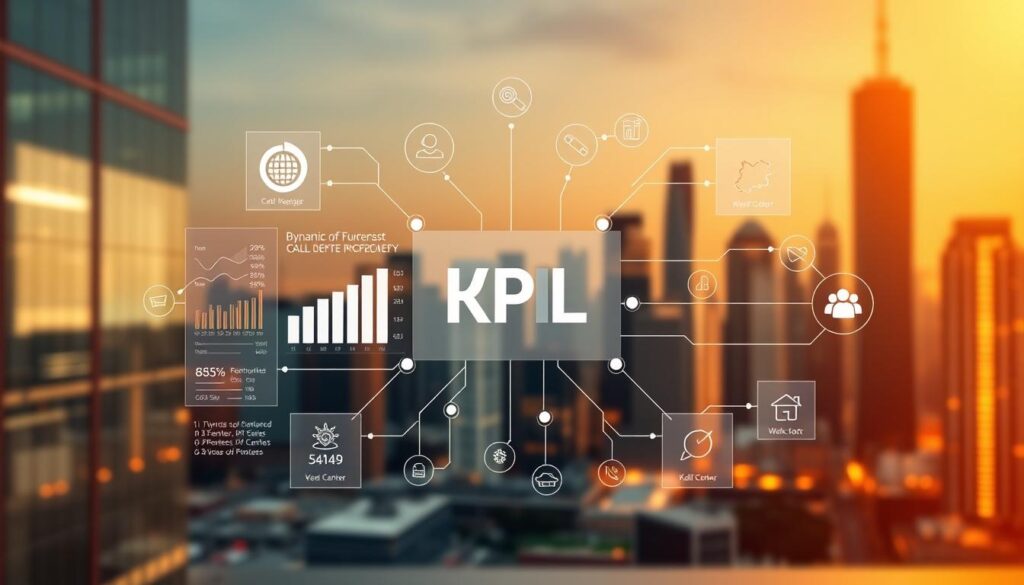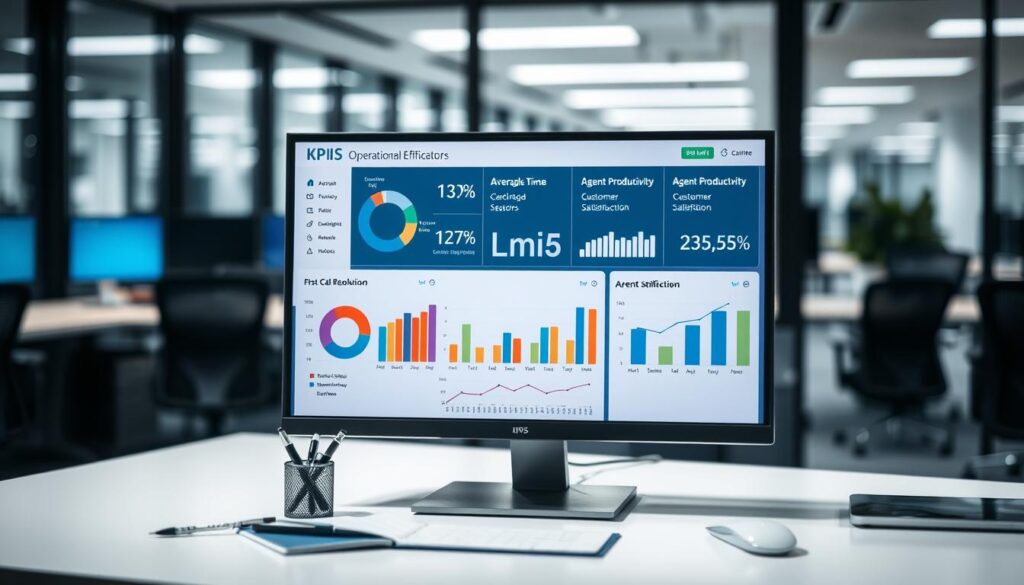Did you know 85% of customers switch brands after just one poor support interaction? This startling statistic highlights why tracking the right metrics isn’t optional—it’s vital for survival in today’s competitive landscape.
Key performance indicators (KPIs) act as a compass for contact centers. They reveal how efficiently teams resolve issues, manage workflows, and deliver satisfying experiences. Managers rely on these data points to spot trends, optimize training, and reduce wasted resources.
When teams prioritize measurable outcomes, they unlock real improvements. For example, analyzing average handle time alongside customer satisfaction scores can highlight gaps in agent preparedness. This dual focus ensures speed doesn’t compromise service quality.
Choosing the best metrics requires balancing operational needs with customer expectations. The right mix helps leaders demonstrate value to stakeholders while fostering a culture of accountability. Actionable insights become the foundation for strategic decisions—from staffing adjustments to tech investments.
Ultimately, effective measurement transforms vague goals into clear pathways for growth. By focusing on what truly matters, businesses turn everyday interactions into opportunities to build loyalty and drive revenue.
Introduction
How often do customers form lasting opinions about a brand during their first phone interaction? Inbound teams handling voice support aren’t just troubleshooting issues—they’re shaping perceptions that influence loyalty and revenue.
Context and Relevance
Voice support remains the preferred channel for 69% of consumers when resolving complex issues. These interactions set the tone for ongoing relationships. Teams must balance speed with empathy to deliver memorable service.
Without clear metrics, managers operate blindly. Tracking outcomes like resolution rates and sentiment analysis reveals patterns. Are agents equipped to handle recurring problems? Do workflows prioritize urgent cases effectively?
How KPIs Drive Success
Data transforms guesswork into strategy. For instance, monitoring first-contact resolution alongside customer satisfaction scores highlights training gaps. Teams can then allocate coaching hours to specific skill deficiencies.
Resource optimization becomes precise when metrics guide decisions. Scheduling adjustments based on call volume trends reduce wait times. Targeted tech investments—like AI-powered knowledge bases—streamline information retrieval during live conversations.
Overview of Call Center Metrics
What separates thriving contact centers from struggling ones? The answer lies in their ability to measure what matters. Metrics act as a navigation system for operations, turning raw data into actionable strategies.

What Are KPIs?
Key performance indicators (KPIs) are measurable values showing how effectively teams achieve objectives. They track everything from wait times to resolution rates. For example, monitoring average handle time reveals whether agents balance speed with thoroughness.
These measurements fall into three categories:
| Category | Purpose | Examples |
|---|---|---|
| Customer-Facing | Measure service quality | CSAT, First Contact Resolution |
| Agent-Focused | Evaluate individual contributions | Adherence to Schedule, Conversion Rates |
| Operational | Assess workflow efficiency | Cost per Call, Abandonment Rates |
Benefits of Measuring Performance
Tracking metrics uncovers hidden opportunities. Managers spot trends like recurring customer complaints or uneven agent productivity. This data guides coaching sessions and tech upgrades.
Teams using KPIs effectively reduce costs by 23% on average. They also improve customer retention through faster issue resolution. Regular reviews create accountability, ensuring everyone aligns with organizational goals.
Importance of KPI Measurement in Customer Service
Effective teams don’t guess—they measure, adapt, and excel using precise metrics. Leaders who track the right indicators spot trends before they become crises. Consider this: 66% of companies rank customer satisfaction as their top priority, yet only 32% consistently meet those goals without data-driven strategies.

Impact on Customer Experience
Metrics act as early warning systems for service gaps. When a telecom company noticed rising complaint rates about billing errors, their first-call resolution KPI dropped to 68%. By cross-referencing this with customer feedback, they retrained teams on payment systems—boosting satisfaction scores by 41% in three months.
Real-time dashboards help managers reroute calls during peak hours. This prevents long wait times that frustrate customers. Teams using these tools report 29% fewer escalations to supervisors.
Role in Agent Training and Productivity
Performance data transforms generic coaching into targeted skill development. A retail brand discovered 40% of their agents struggled with returns processing. Customized training modules reduced handling time by 22% while improving accuracy.
| Training Approach | Result |
|---|---|
| Without KPI Insights | 18% improvement in 6 months |
| With KPI-Driven Coaching | 53% improvement in 6 months |
Productivity metrics also reveal workflow bottlenecks. One financial services firm adjusted break schedules based on call volume patterns—increasing available staff during crunch times by 37%.
Enhancing Call Center Performance with Top KPIs
Why do some teams consistently outperform others despite similar resources? The answer lies in their ability to focus on high-impact measurements that align with broader business goals. A well-designed KPI framework acts like a spotlight, illuminating what truly drives progress.

Establishing a KPI Framework
Start by identifying three to five core objectives. For example, a telecom company might prioritize reducing repeat contacts while improving agent confidence scores. This dual focus ensures efficiency gains don’t compromise service quality.
Effective frameworks balance real-time data with long-term trends. Consider this breakdown for different focus areas:
| Focus Area | Short-Term Metric | Long-Term Indicator |
|---|---|---|
| Service Quality | First Response Time | Customer Retention Rate |
| Team Efficiency | Calls per Hour | Cost per Resolved Issue |
| Employee Growth | Coaching Completion | Promotion Rate |
Key Areas for Improvement
Leading organizations analyze customer journeys to pinpoint friction points. One retail brand discovered 62% of escalations stemmed from unclear return policies—a fixable process issue masked by surface-level metrics.
Prioritize metrics that reveal root causes rather than symptoms. Tracking average handle time alongside customer effort scores helps teams balance speed with thoroughness. Regular calibration ensures your dashboard evolves with shifting priorities.
Measuring Customer Experience Metrics
What determines whether customers stay loyal or quietly walk away? Three metrics—CSAT, NPS, and CES—hold the answers. These tools decode satisfaction levels, loyalty drivers, and friction points in every interaction.
CSAT, NPS, and CES Explained
Customer Satisfaction (CSAT) scores focus on specific interactions. Calculate yours by dividing 4-5 star ratings by total responses, then multiplying by 100. A telecom company boosted retention 18% by tracking this weekly.
Net Promoter Score (NPS) measures loyalty through one question: “How likely are you to recommend us?” Responses fall into three groups:
- Promoters (9-10): Loyal enthusiasts
- Passives (7-8): Neutral users
- Detractors (0-6): Unhappy customers
Customer Effort Score (CES) reveals how easily issues get resolved. Lower scores signal processes needing simplification. One retailer reduced returns-related calls by 34% after streamlining their CES-driven workflow.
| Metric | Primary Purpose | Ideal Benchmark |
|---|---|---|
| CSAT | Interaction-specific satisfaction | 85%+ |
| NPS | Long-term loyalty | 40+ |
| CES | Process efficiency | 2.0 (1-5 scale) |
Improving Customer Satisfaction
Analyze CSAT trends to identify training gaps. Teams scoring below 80% often need better product knowledge coaching. Pair this with CES data to simplify complex workflows causing repeat contacts.
NPS improvements come from addressing detractors’ concerns. A software company increased promoters by 29% in six months through targeted follow-ups with low scorers. Monthly reviews of all three metrics create a complete picture of experience quality.
Assessing Agent Performance Metrics
How do top-performing teams consistently deliver exceptional service? The secret lies in tracking metrics that reveal individual strengths and workflow gaps. Two critical measurements—agent utilization and handle time—offer actionable insights into productivity and service quality.

Agent Utilization and Average Handle Time
Agent utilization rate shows how effectively reps use their scheduled hours. Calculate it by multiplying average calls handled by their duration, then dividing by total work hours. For example:
| Metric | Formula |
|---|---|
| Utilization Rate | (Calls Handled × Avg. Call Time) ÷ Work Hours × 100 |
| Average Handle Time | (Talk + Hold + Wrap-up Time) ÷ Total Calls |
Teams maintaining 80-85% utilization balance productivity without burnout. Handle time analysis identifies training needs—like reducing hold durations for complex billing inquiries.
Monitoring First Response and Resolution Rates
Speed matters, but so does accuracy. Track first response time to ensure quick acknowledgments. Pair this with first-call resolution rates to gauge problem-solving efficiency. A 90% resolution rate with 30-second response times often signals well-trained agents.
Key benchmarks include:
- Under 60 seconds for initial replies
- 75%+ first-contact resolutions
- Weekly reviews of repeat call patterns
These metrics highlight where coaching can reduce escalations and improve customer trust.
Operational Metrics for Efficient Call Centers
What’s the tipping point where long wait times push customers to competitors? Operational metrics answer this by revealing patterns in incoming calls and resource allocation. Teams balancing speed and availability reduce frustration while maintaining service quality.

Calls Handled vs. Call Abandonment
Calls handled measures successful interactions during shifts. A high count with low abandonment rates signals efficient staffing. Use this formula to track disconnections:
- Abandonment Rate = [(Total Calls Received − Calls Handled) ÷ Total Calls Received] × 100
For example, handling 850 of 900 incoming calls yields a 5.5% abandonment rate. Rates above 8% often indicate understaffing or complex workflows needing simplification.
Average Speed of Answer and Hold Time
Average speed of answer (ASA) tracks how quickly agents connect. Aim for under 30 seconds—longer waits spike frustration. Combine ASA with hold time analysis to identify bottlenecks.
| Metric | Ideal Benchmark | Action Trigger |
|---|---|---|
| ASA | ≤ 30 seconds | Staffing adjustments |
| Hold Time | ≤ 45 seconds | Process streamlining |
Teams reducing hold durations by 20% often see abandonment rates drop proportionally. Real-time monitoring helps managers redistribute calls during surges, protecting customer patience.
Financial Metrics: Cost per Call and Beyond
How much does each customer interaction really cost your business? Financial metrics expose hidden inefficiencies that drain budgets and hinder growth. Tracking these numbers helps leaders balance service quality with fiscal responsibility.

Understanding Cost Implications
Cost per call (CPC) reveals the average expense of resolving a customer issue. Calculate it by dividing total operational costs by handled interactions. For example:
- Monthly expenses: $50,000
- Calls handled: 10,000
- CPC = $5.00
This benchmark helps identify overspending. Teams exceeding industry averages often need process audits. Common fixes include automating repetitive tasks or upgrading outdated systems.
Three strategies effectively reduce CPC without sacrificing service:
| Strategy | Impact | Implementation Time |
|---|---|---|
| Remote Teams | 23% lower overhead | 2-4 weeks |
| AI Chatbots | 34% fewer simple inquiries | 6-8 weeks |
| Skill-Based Routing | 19% faster resolutions | 3-5 weeks |
Regularly reviewing productivity metrics ensures cost cuts don’t backfire. Pair CPC trends with customer satisfaction scores to maintain quality. A healthcare provider slashed per-call expenses by 31% using this approach while improving CSAT by 14 points.
Cloud-based CRMs often deliver quick wins. These tools centralize customer data, reducing average handle time by 28% in some cases. Managers gain real-time visibility into spending patterns, enabling smarter budget decisions.
Leveraging Technology for Real-Time Insights
Modern support teams thrive when equipped with tools that turn data into instant action. Real-time analytics platforms now analyze every interaction, spotting trends while conversations unfold. This shift transforms reactive strategies into proactive solutions.
Utilizing Dashboards and Monitoring Tools
AI-powered dashboards review 100% of customer interactions, flagging areas needing attention. For example, Zendesk QA automatically detects training gaps by comparing agent responses to best practices. These systems highlight recurring issues like billing confusion or policy misunderstandings.
Workforce management tools track team activity minute-by-minute. Features like AI-driven scheduling match staff availability with predicted call volumes. Real-time alerts notify supervisors when wait times spike, enabling swift resource redistribution.
Integrating these technologies improves productivity without overwhelming teams. Automated reports summarize key metrics like resolution speed and customer sentiment. Leaders gain clarity on what’s working—and where processes need refinement—through visual, digestible insights.


